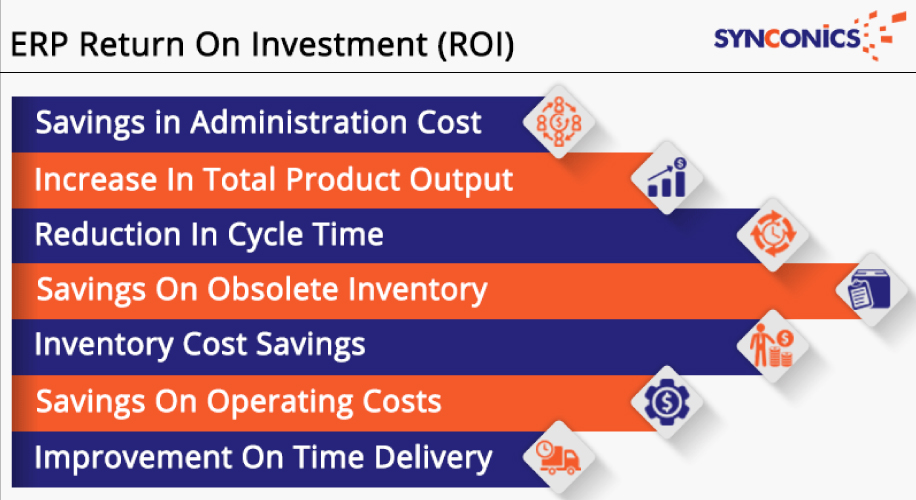Return On Investment (ROI) On ERP Implementation
ERP system implementation can impact your business very broadly, and sometimes in unexpected ways. Not all of these impacts are easily measurable, but an ROI analysis is a helpful starting point. Of course, the situation matters, and you will need to apply your best judgment based on the circumstances.
At Synconics, we recognize that selecting an ERP system is a substantial investment in terms of time and money. Estimating the ROI before selecting and purchasing an ERP system can help lower overall costs.
When a proposal is put forward for implementing an ERP system, two questions are invariably asked:
How much it is going to cost?
What is the payback period?
Return On Investment (ROI) On ERP Implementation
ERP system implementation can impact your business very broadly, and sometimes in unexpected ways. Not all of these impacts are easily measurable, but an ROI analysis is a helpful starting point. Of course, the situation matters, and you will need to apply your best judgment based on the circumstances.
At Synconics, we recognize that selecting an ERP system is a substantial investment in terms of time and money. Estimating the ROI before selecting and purchasing an ERP system can help lower overall costs.
When a proposal is put forward for implementing an ERP system, two questions are invariably asked:
How much it is going to cost?
What is the payback period?

ROI in the context of an ERP project:
Return on investment does not just imply in terms of financial gain. It can be in terms of the growth in productivity, efficiency, or in terms of overall improvement in the performance of the company or even to the extent of better transparency in the operations being carried out by the firm and of course, the satisfaction of the users.
While going for ERP implementation, it is very essential that the return on investment does not just imply in terms of financial gain. Of course yes, there are financial gains in the long run. But, let us see, what the other ways of realizing a significant return on investments are.
Streamlined processes:- Existing processes are streamlined properly due to proper flow in data across departments.
Data Consistency:- Streamlined processes result in consistency of data across the organization as it is centralized. There is no need for every department to store data separately.
Improvements in productivity:- Data consistency removes the burden of impertinent work from staff and managers. This helps them concentrate in their core duties and hence results in improved productivity.
Reduction in redundancy:- Centralized database ensures that the customer order need not be stored in separate departments redundantly. One unique id generated per customer or per order, helps various departments access the same data.
Increased transparency:- As told before, a unique id for every order helps departments know the status of the order well in advance. This results in transparency across the organization and helps individual process managers plan in advance.
Key ERP ROI Measurement Parameters:
Reduced level of inventory through improved planning and control.
Improved production efficiency which minimizes shortages and interruptions.
Reduced materials cost through improved procurement and payment protocols.
Reduced labor cost through better allocation of staff and reduced overtime.
Increased sales revenue, driven by better managed customer relationships.
Increased gross margin percentage.
Reduced administrative costs.
Reduced regulatory compliance costs.